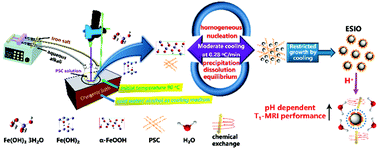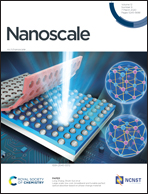Moderate cooling coprecipitation for extremely small iron oxide as a pH dependent T1-MRI contrast agent†
Abstract
Iron based nanomedicine (IBNM) has been one powerful diagnostic tool as a magnetic resonance imaging (MRI) contrast agent (CA) in the clinic for years. Conventional IBNMs are generally employed as T2-MRI CAs, but most of them are constrained in clinical indication expansion by magnetic susceptibility artifacts. In comparison, extremely small iron oxide (ESIO) with a core size less than 5 nm has demonstrated the T1-MRI effect, which provides prospects for a Gd-based agent alternative. Nevertheless, currently developed ESIOs for T1-MRI CAs always require harsh conditions such as a high temperature and high boiling point reagent. Moreover, very few of the currently developed ESIOs meet the stringent pharmaceutical standard. Herein, on the basis of a crystal nuclear precipitation–dissolution equilibrium mechanism and outer/inner sphere T1-MRI theory, monodisperse ESIOs with an average size of 3.43 nm (polydispersity index of 0.104) are fabricated using a moderate cooling procedure with mild coprecipitation reaction conditions. The as-synthesized ESIOs display around 3-fold higher T1 MRI signal intensity than that of commercial Ferumoxytol (FMT), comparable to that of Gd-based CAs in vitro. Additionally, the T1-MRI performance of the ESIOs is pH dependent and delivers bright signal augmentation. Eventually, the internalization into mesenchymal stem cells of the ESIO is realized in the absence of a transferring agent. Considering the identical structure and composition of the ESIOs as compared to that of FMT, they could meet the pharmaceutical criteria, thus providing great potential as T1-MRI Cas, for instance as stem cell tracers.



 Please wait while we load your content...
Please wait while we load your content...